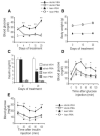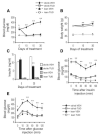Chemical chaperones reduce ER stress and restore glucose homeostasis in a mouse model of type 2 diabetes
- PMID: 16931765
- PMCID: PMC4741373
- DOI: 10.1126/science.1128294
Chemical chaperones reduce ER stress and restore glucose homeostasis in a mouse model of type 2 diabetes
Abstract
Endoplasmic reticulum (ER) stress is a key link between obesity, insulin resistance, and type 2 diabetes. Here, we provide evidence that this mechanistic link can be exploited for therapeutic purposes with orally active chemical chaperones. 4-Phenyl butyric acid and taurine-conjugated ursodeoxycholic acid alleviated ER stress in cells and whole animals. Treatment of obese and diabetic mice with these compounds resulted in normalization of hyperglycemia, restoration of systemic insulin sensitivity, resolution of fatty liver disease, and enhancement of insulin action in liver, muscle, and adipose tissues. Our results demonstrate that chemical chaperones enhance the adaptive capacity of the ER and act as potent antidiabetic modalities with potential application in the treatment of type 2 diabetes.
Figures





References
Publication types
MeSH terms
Substances
Grants and funding
LinkOut - more resources
Full Text Sources
Other Literature Sources
Medical

